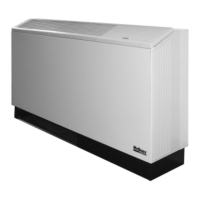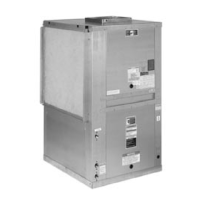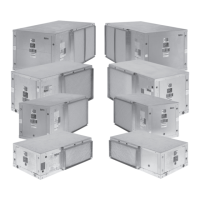Page 8 / IM 447
Electrical Data
Environment
This equipment is designed for indoor installation only.
Sheltered locations such as attics, garages, etc., generally
will not provide sufficient protection against extremes in
temperature and/or humidity, and equipment performance,
reliability, and service may be adversely affected.
Additional Information
Units are designed to start and operate with entering air at
40˚F (4˚C), with entering water at 70˚F (21˚C), with both air
and water at the flow rates used in the ARI-Standard 320-86
rating test, for initial start-up in winter.
Note: This is not a normal or continuous condition. It is
assumed that such a start-up is for the purpose of bringing
the building space to occupancy temperature.
Air and Water Limits
Cooling Heating
Min. Ent. Air ➀ ➁ 65˚F (18˚C) 55˚F (14˚C)
Normal Ent. Air. db/wb 80/67˚F (27/19˚C) 70˚F (21˚C)
Max. Ent. Air ➀ ➁ 90˚F (32˚C) 80˚F (27˚C)
Water Enthalpy
Cooling Heating
Min. Ent. Air ➀ ➁ 60˚F (16˚C) 55˚F (14˚C)
Normal Ent. Air. db/wb 85˚F (29˚C) 70˚F (21˚C)
Max. Ent. Air ➀ ➁ 110˚F (43˚C) 90˚F (32˚C)
➀ At ARI flow rate.
➁ Maximum and minimum values may not be combined. If one value is
at maximum or minimum, the other two conditions may not exceed
the normal condition for standard units.
General
1. Be sure the available power is the same voltage and
phase as that shown on the unit serial plate. Line and
voltage wiring must be done in accordance with
local codes or the National Electrical Code, which-
ever is applicable.
2. Apply correct line voltage to the unit. A disconnect
switch near the unit is required by code. Power to the
unit must be sized correctly and have dual element
(Class RK5) fuses or HACR circuit breaker for branch
circuit overcurrent protection. See the nameplate for
correct ratings.
3. All 208-230V single phase units are factory wired for 208
volt operation unless specified for 230 volts.
Operating Voltages:
115/60/1 . . . . . . . . . . . . . . . 104 volts min.; 127 volts max.
208-230/60/1 . . . . . . . . . . . 197 volts min.; 253 volts max.
265/60/1 . . . . . . . . . . . . . . . 238 volts min.; 292 volts max.
230/50/1 . . . . . . . . . . . . . . . 197 volts min.; 253 volts max.
Note: Voltages listed are to show voltage range. However, units operating
with overvoltage or undervoltage for extended periods of time will experience
premature component failure.
General
Note: At start-up of unit, ensure that temperature, flow rate
and voltage are within specified limits required for proper
unit operation. Each unit has its own control or remote
control, utilizing an internal thermostat (unit mounted) and
touch-pad selector switch or a wall mounted thermostat
(remote control units).
Mark IV/AC-Control Units
Each unit has a Mark IV/AC version printed circuit board. Its
control is available in unit mounted or remote wall thermostat.
The low voltage output from the low voltage terminal strip
on the control board is always 24 volts AC. Terminals F and
V on the low voltage terminal strip supply 24 volts
DC-power.
Continuous Fan: Units are factory wired for continuous
operation. When power is applied and the start switch is
depressed, the fan will run.
Cooling or Heating – Auto Operation: Rotate the thermostat
knob to either warmer or cooler. Select fan speed. Depress
the start button. Unit will start within 0 to 32 seconds.
Lockout Circuit: Each unit has its own lockout circuit to
lock out compressor operation when an abnormal condition
should appear. During unit operation, the compressor will be
automatically turned off due to one of the two safety
openings. High pressure is set at 400 psi (2760 kPa) and low
temperature switch is set at 28˚F (-2˚C). Condensate over-
flow and brownout protection are also included.
Remote Reset of Automatic Lockouts: The Remote Reset
feature provides the means to remotely reset automatic
lockouts generated by high-pressure and/or low-tempera-
ture (in heating) faults. When the Mark IV board is in auto-
matic lockout due to one of these faults, and the cause of the
fault condition has been alleviated, energizing the O-terminal
for 10 seconds or more will force the Mark IV board to clear
the lockout. A unit power cycle can also be used to clear an
automatic lockout if the conditions causing the fault have
been alleviated.
Fault Retry To Minimize Nuisance Trips: The Fault Retry
feature helps to minimize nuisance trips of automatic lock-
outs caused by high-pressure and/or low-temperature (in
heating) faults. This feature clears faults the first two times
they occur within a 24-hour period and triggers an auto-
matic lockout on the 3rd fault. The retry count is reset to
zero every 24 hours.
Cooling or Heating – Manual Operation: Rotate the
thermostat knob to either warmer or cooler. Select fan
speed, depress the heat or cool button, and unit will start
within 0 to 32 seconds.
The Mark IV/AC-circuit board system has built-in features
such as random start, compressor time delay, night setback,
load shed, shutdown, condensate overflow protection, defrost
cycle, brownout, and LED/fault outputs. Figure 7 shows the
LED and fault output sequences. The 24 volt low voltage
terminal strip is set so R-G energizes the fan. R-W1 energizes
the fan and compressor and reversing valve for heating
operation.
The reversing valve is set up to be energized in the
heating mode. The circuit board has a fan interlock circuit to
energize the fan whenever the compressor is on.
The Mark IV/AC control board has a lockout circuit to
stop compressor operation if any one of its safeties opens
(high pressure or low temperature). If the low temperature
thermostat opens, the unit will go into the cooling mode for
60 seconds to defrost any slush in the water-to-refrigerant
Operating Limits
Unit Operation

